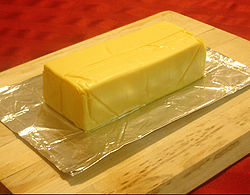Velveeta
| Velveeta | |
|---|---|
 | |
| Country of origin | United States |
| Region, town | Monroe, New York |
| Source of milk | Cow |
| Pasteurized | Yes |
| Texture | Soft, "creamy" |
| Fat content | 21% |
| Protein content | 18% |

Velveeta is the brand name of a processed cheese product having a taste that is identified as a type of American cheese, but with a softer and smoother texture than cheese. As a result, when melted/heated, Velveeta maintains a fully integrated, and evenly clump-free liquid texture—the opposite of what results when cheese is melted or cooked at high heat. It was invented in 1918 by Emil Frey of the Monroe Cheese Company in Monroe, New York. In 1923, The Velveeta Cheese Company was incorporated as a separate company, and was sold to Kraft Foods in 1927. The product was advertised at the time as a nutritious health food.[1] According to Kraft's website, in the 1930s, Velveeta became the first cheese product to gain the American Medical Association's seal of approval.[2] It was reformulated in 1953 as a cheese spread.[2] Velveeta is labeled in the United States as a "Pasteurized Recipe Cheese Product" (see processed cheese). The name "Velveeta" is intended to connote a velvety smooth edible product.[3] Smoothness and melting ability are promoted as its properties that result by reincorporating the whey with the curd. The brand has also been successfully spun off into a varied, Velveeta-based product line.
Use
This section needs expansion. You can help by adding to it. (March 2010) |
One of the most popular uses for Velveeta is as the base in queso dip.[4] Other popular uses for Velveeta include grilled cheese sandwiches and filler for macaroni and cheese sauce.[4]
Ingredients
Milk, whey, skim milk, milk protein concentrate, water, milkfat, whey protein concentrate, sodium phosphate, modified food starch; contains less than 2% of: salt, calcium phosphate, dried corn syrup, canola oil, malto dextrin, lactic acid, sorbic acid as a preservative, sodium alginate, sodium citrate, cheese culture, enzymes, apocarotenal (color), annatto (color) Source: [5]
Marketing and advertising
Velveeta is currently sold in the United States, Canada, Hong Kong, the Philippines, and South Korea. In the 1930s and 1940s, it was sold in the United Kingdom and in Germany (as "Velveta").[6]
In the 1980s, Velveeta used the advertising jingle, "Colby, Swiss and Cheddar, blended all together" in its US television commercials to explain its taste and texture, because at that time genuine cheese was used in its recipe.[7]
Classification
In 2002, the FDA issued a Warning Letter to Kraft that Velveeta was being sold with packaging that described it as a "Pasteurized Process Cheese Spread",[8] which the FDA claimed was misbranded because the product declared milk protein concentrate (MPC) in its ingredients listing. Velveeta is now sold in the US as a "Pasteurized Prepared Cheese Product",[9] a term for which the FDA does not maintain a standard of identity, and which therefore may contain MPC.
As is the case with most processed cheeses, the manufacturer recommends Velveeta be refrigerated after opening.
See also
References
- ^ Wyman, Carolyn Better than Homemade:Amazing Food that Changed the Way We Eat Quirk Books 2004
- ^ a b Velveeta Brand History, Accessed 23 December 2010.
- ^ Geiling, Natasha. "There is No Shortage of History When it Comes to Velveeta". smithsonianmag.com. Smithsonian Magazine. Retrieved 18 October 2014.
- ^ a b "Kraft Foods". Retrieved 2012-10-21.
- ^ Velveeta box
- ^ "Ciao! price comparison site". Retrieved 2010-04-04.
- ^ "Velveeta Cheese Spread (YouTube)". Retrieved 2012-01-06.
- ^ WARNING LETTER CHI-6-03, U.S. Food and Drug Administration to Kraft Foods North America, Inc. 18 December 2002. Accessed 9 February 2010.
- ^ "What Is 'Real Kraft Cheese'?", Chicago Business, February 5, 2007. Accessed 3 February 2008.
